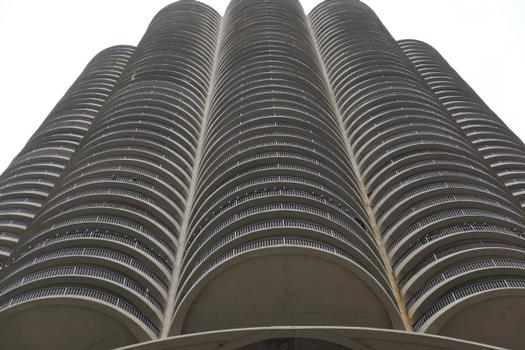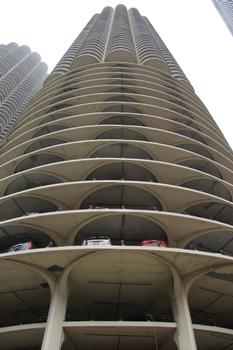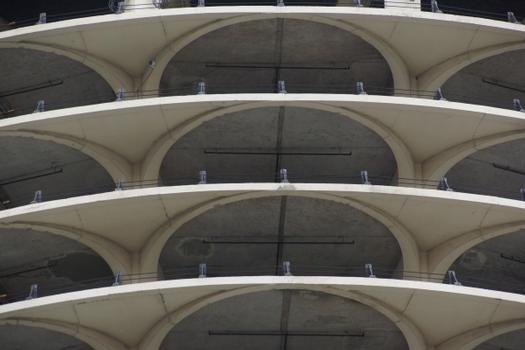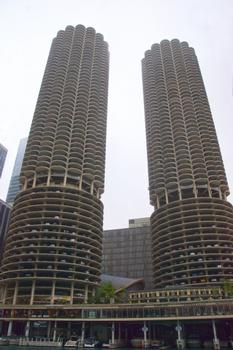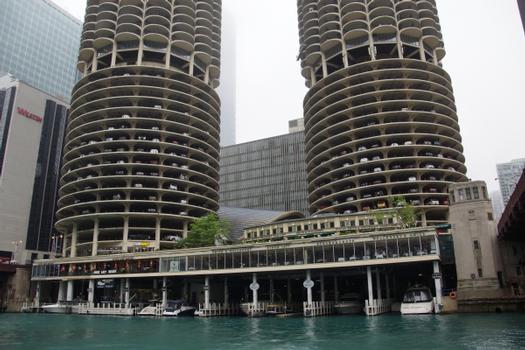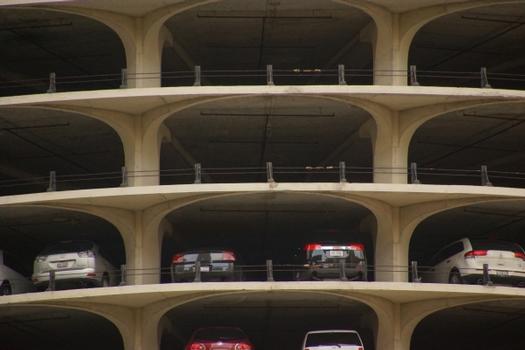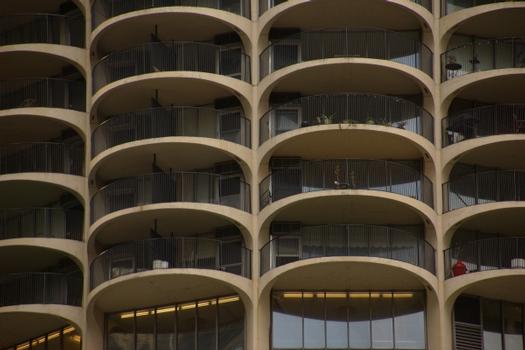General Information
Project Type
| Function / usage: |
Apartment building Parking garage / parking structure |
|---|---|
| Material: |
Reinforced concrete structure |
Awards and Distinctions
| 2016 |
for registered users |
|---|
Location
| Location: |
Chicago, Cook County, Illinois, USA |
|---|---|
| Coordinates: | 41° 53' 16.82" N 87° 37' 44.93" W |
| Coordinates: | 41° 53' 17.82" N 87° 37' 42.47" W |
Technical Information
Dimensions
| height | 179 m |
Cost
| cost of construction | United States dollar 36 000 000 |
Materials
| building structure |
reinforced concrete
|
|---|
Excerpt from Wikipedia
Marina City is a mixed-use residential-commercial building complex in Chicago, Illinois, United States, North America, designed by architect Bertrand Goldberg. The multi-building complex opened between 1963 and 1967 and occupies almost an entire city block on State Street on the north bank of the Chicago River on the Near North Side, directly across from the Loop. Portions of the complex were designated a Chicago Landmark in 2016.
The complex consists of two 587-foot (179 m), 65-story apartment towers, opened in 1963, which include physical plant penthouses. It also includes a 10-story office building (now a hotel) opened in 1964, and a saddle-shaped auditorium building originally used as a cinema. The four buildings, access driveways, and a small plaza that originally included an ice rink are built on a raised platform next to the Chicago River. Beneath the platform, at river level, is a small marina for pleasure craft, giving the structures their name.
History
The Marina City complex was designed in 1959 by architect Bertrand Goldberg and constructed between 1961 and 1968 at a cost of $36 million, financed to a large extent by Building Service Employees International Union, a union of building janitors and elevator operators, who sought to reverse the pattern of white flight from the city's downtown area. When finished, the two towers were both the tallest residential buildings and the tallest reinforced concrete structures in the world. The complex was built as a "city within a city", featuring numerous on-site facilities including a theater, gym, swimming pool, ice rink, bowling alley, stores, restaurants, and, of course, a marina.
Marina City was built in a joint venture with Brighton Construction Company (owner: Thomas J. Bowler) and James McHugh Construction Company. James McHugh Construction Co. subsequently built Water Tower Place in 1976 and Trump Tower in 2009, both of which were also the tallest reinforced concrete structures in the world at the times they were built. Marina City was the first building in the United States to be constructed with the Linden climbing tower cranes.
WLS-TV (ABC Channel 7) transmitted from an antenna atop Marina City until the Willis Tower (formerly known as Sears Tower) was completed. Local radio station WCFL operated out of Marina City in the office building of the complex. Local television station WFLD (FOX Channel 32) had its studios and transmitter at Marina City for 18 years until they were bought by Metromedia.
Marina City was the first post-war urban high-rise residential complex in the United States and is widely credited with beginning the residential renaissance of American inner cities. Its model of mixed residential and office uses and high-rise towers with a base of parking has become a primary model for urban development in the United States and throughout the world, and has been widely copied throughout many cities internationally.
Architecture
The two towers contain identical floor plans. The bottom 19 floors form an exposed spiral parking ramp operated by valet with approximately 896 parking spaces. The 20th floor of each contains a laundry room and gym with panoramic views of the Loop, while floors 21 through 60 contain apartments (450 per tower). A 360-degree open-air roof deck lies on the 61st and top story. The buildings are accessed from separate lobbies that share a common below-grade mezzanine level as well as ground-level plaza entrances beside the House of Blues. Originally rental apartments, the complex converted to condominiums in 1977, but still contains a number of rental units.
Marina City apartments are unusual in containing almost no interior right angles. On each residential floor, a circular hallway surrounds the elevator core, which is 32 feet (9.8 m) in diameter, with 16 sector-shaped units arrayed around the hallway. Apartments are composed of these units. Bathrooms and kitchens are located towards the inside of the building. Living areas occupy the outermost areas of each unit. Each unit terminates in a 175-square-foot (16.3 m²) semi-circular balcony, separated from living areas by a floor-to-ceiling window wall. Because of this arrangement, every single living room and bedroom in Marina City has a balcony.
The apartments are also unusual in that they function solely on electricity; neither natural gas nor propane serves any function. The apartments are not provided with hot water, air conditioning, or heat from a central source, as was the common practice at the time the towers were built. Instead, each unit contains individual water heaters, heating and cooling units, and electric stoves; residents pay individually for the electricity needed to run these appliances. This might have been a financial decision on the part of the building owners; at the time these towers were constructed, local electric utility Commonwealth Edison provided expensive building transformers at little or no charge, provided the buildings were made all-electric.
In addition, the residential towers are noted for the high speed of their elevators. It takes approximately 33 seconds to travel from the lower-level lobby to the 61st floor roof decks.
The towers were awarded a prize by the New York Chapter of the American Institute of Architects in 1965 for their innovation.
The appearance of the towers is said to have inspired a similar design for the Corinthian Tower in New York.
In 2007, the condominium board controversially claimed to own the common law copyright and trademark rights to the name and image of the buildings, although they do not own the parking garage portion of the buildings located below the 20th floor. They have claimed that any commercial use (such as in film or other media, such as on web sites) of pictures of the buildings or of the name "Marina City" without permission is a violation of their intellectual property rights.
In celebration of the 2018 Illinois Bicentennial, Marina City was selected as one of the Illinois 200 Great Places by the American Institute of Architects Illinois component (AIA Illinois).
Current use
The complex houses the House of Blues concert hall, restaurant and bar, the Hotel Chicago, 10Pin Bowling Lounge, and four restaurants (Yolk, Smith and Wollensky, Katana, and Dick's Last Resort).
The House of Blues concert hall was built in the shell of the complex's long-disused movie theater. Similarly, the hotel was built in what was once the Marina City office building. In order to accommodate Smith and Wollensky, the former skating rink was demolished. Pedestrian and vehicular access to the residential towers and the raised common plaza were redesigned. In 2006, decorative lighting was installed around the circular roofs of the mechanical sheds that top each tower; the towers had not contained any such lighting since the 1960s.
Views
To the south, the towers overlook the main branch of the Chicago River with a commanding view of the Chicago Loop beyond it. To the west, the towers offer views of the division of the Chicago River between its north and south branches, the Merchandise Mart, the Willis Tower, and the vast westward expanse of the city. To the north, the towers face Chicago's River North, Old Town, and Gold Coast neighborhoods and the northern neighborhoods of Chicago as they extend toward Evanston. To the east the Towers afford a view of the eastern terminus of the Chicago River, Lake Michigan, Navy Pier, and Grant Park.
From the condominium floors, on a clear day it is possible to see office buildings abutting Interstate 294, located more than 20 miles (32 km) to the west. On spring and summer nights, the towers also have a view of illuminated Wrigley Field during evening baseball games, 4.5 miles (7.2 km) to the north.
Many of the views from the towers will be obstructed due to new construction in the immediate future. After more than 40 years of unimpeded north and northwest views, in spring 2006 construction began on vacant lots immediately northwest of the towers at the intersection of North Dearborn and West Kinzie Streets for separate projects, including a mid-rise hotel and a high-rise office building, which is expected to partially obscure views from Marina City in these directions. Also in 2006, site preparation began on a high-rise office building west of Marina City at North LaSalle Street and the Chicago River which, when completed, will eliminate the unimpeded view of the western horizon from Marina City's uppermost floors and roof decks.
Text imported from Wikipedia article "Marina City" and modified on July 22, 2019 according to the CC-BY-SA 4.0 International license.
Participants
-
Bertrand Goldberg Associates
- Bertrand Goldberg (architect)
- Hannskarl Bandel (structural engineer)
Relevant Web Sites
Relevant Publications
- : Architects + Engineers = Structures. Academy Editions, New York (USA), pp. 62-63.
- (2015): Marina City - The History and Restoration of an Iconic Facade. Presented at: IABSE Conference: Structural Engineering: Providing Solutions to Global Challenges, Geneva, Switzerland, September 2015, pp. 482-483.
- (2017): Marina City—The History and Restoration of an Iconic Façade. In: (2017): Engineering History and Heritage Structures – Viewpoints and Approaches. International Association for Bridge and Structural Engineering (IABSE), Zurich (Switzerland), ISBN 978-3-85748-154-3, pp. 61-66.
- (1996): Skyscrapers. Black Dog & Loventhal, New York (USA), pp. 58-59.
- (2008): Skyscrapers. A History of the World's Most Extraordinary Buildings. 2nd edition, Black Dog & Leventhal Publishers, Inc., New York (USA), ISBN 978-1-57912-787-9, pp. 60-61.
- About this
data sheet - Structure-ID
20000247 - Published on:
19/05/1999 - Last updated on:
26/06/2015


